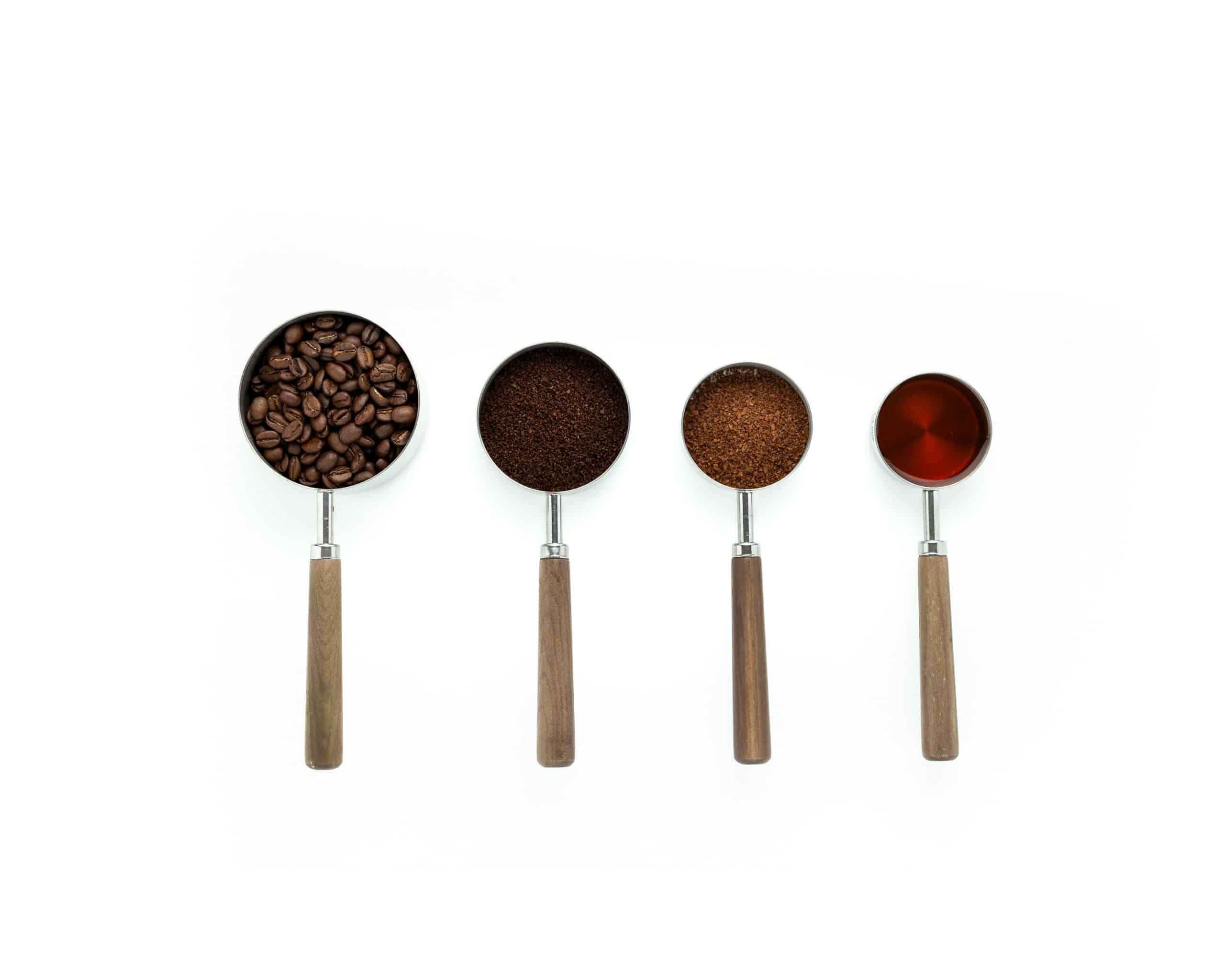Whether you stick to drip coffee or have a soft spot for lattes topped with elaborate artwork, there’s no denying the importance (some would argue the utmost importance) of selecting the right type of coffee in the morning. The sheer number of choices when it comes to popular types of coffee drinks is both welcome and sometimes overwhelming. If you’ve ever had questions about types of coffee or even wondered how to make your own versions of your favorite coffee drinks at home, we’re here to help you transform from being coffee-curious to a full-fledged coffee bean connoisseur and at-home barista.
Choosing Your Beans
All types of coffee drinks worth your morning devotion begin with great coffee beans, and the best place to buy exceptional coffee beans is directly from a coffee roaster. Although a whole wall of different types of coffee beans can be intimidating to choose from, you’ll find that baristas love to talk about their favorite coffee beans and how they can be used. Ben Rugg, lead roaster and manager of Pallet Coffee in Vancouver, British Columbia, loves interacting with customers who are interested in learning more about different types of coffee. “People who work with specialty coffee are extremely passionate about coffee and typically are more than happy to share their knowledge and information on how to make a nice coffee at home.” Choosing coffee beans can be as simple as describing some of your favorite types of coffee to a barista or roaster. Ann Hnatyshyn, head roaster at East Van Roasters (also in Vancouver), suggests thinking about what it is you enjoy about coffee drinks to begin with. “When buying coffee for home, the first thing to keep in mind is what flavor profile you’re looking for. It could be something balanced with lots of chocolate flavor notes, or maybe you enjoy a stronger bitter flavor so you can enjoy cream and sugar in your morning coffee. You can also seek out a coffee with more floral and sweet notes.” Once you’ve identified the flavors you love, it’s time to look at the roast profile of different types of coffee beans.
The Roast With the Most
A coffee bean’s flavor profile is directly linked to the length of time it was roasted. Once you figure out the best roast for your tastes, it becomes much easier to pick out coffee beans. Hnatyshyn says that in general, “Lightly roasted coffee normally has more acidity and sweetness. Medium roasted coffee will be less acidic with some sweetness and some bitterness. Dark roast tends to be more bitter.” If in doubt, try describing the best cup of coffee you’ve ever had to your barista and let them take it from there. Many coffee shops will offer small sample bags of beans, giving you the chance to try them out before committing to a certain roast. 
Price and Origin: Their Effect on Different Types of Coffee Beans
Spencer Viehweger, co-founder and co-owner of Matchstick Coffee, suggests paying attention to price points when exploring different types of coffee beans. “Various price points typically have a flavor spectrum as well. There are many fantastic espresso-style coffees that can be purchased for around $15 to $18 a bag. They won’t have the nuance of the top end stuff, but they can still be delicious. If you’re looking for notes of raspberry or sugarplum, I would expect to pay between $20 and $25 dollars for a premium filter-style coffee.” Viehweger says that in addition to roasting time, the geographical origin of the coffee beans has an impact on the flavors of different types of coffees. “I would also experiment with different growing regions, learn about their unique flavor profiles, and find what best appeals to you! Kenyan coffees are generally very jammy and acidic, Ethiopian coffees are generally quite tropical and floral, and Latin American coffees are typically nutty and chocolatey.”
Get the right kind of grind.
Whether you’re using a French press, a drip coffee maker, or a stovetop or electric espresso maker, it’s important to choose the right grind for the job. As a general rule, Hnatyshyn says, “If you have a home espresso machine then you have to make sure that the grind size is finer compared to a drip filter coffee machine or a French press, which will be a coarser grind size.” Cold brew and Turkish coffee also demand a specific grind, so make sure to check with a barista or coffee roaster if you’re feeling unsure.
Coffee vs. Espresso: What’s the difference?
There is a major difference between drip coffee and espresso—and it’s all about how the coffee beans are ground and treated as a beverage is being made. Beans that have been ground to make espresso are extremely fine, while drip coffee grounds are coarser in texture. When it comes to actually making your beverage of choice, espresso is made in much smaller amounts than drip coffee. The process involves very quickly forcing extremely hot water through coffee grounds that have been tightly packed into an espresso maker. Drip coffee, on the other hand, is made by slowly filtering a larger amount of water through loosely packed coffee grounds. Although espresso has a stronger taste and darker appearance than coffee, a typical serving size actually contains less caffeine than that of drip coffee. A 2-ounce shot of espresso contains 80 mg of caffeine, whereas a 12-ounce cup of drip coffee contains 120 mg of caffeine.
How to Make Espresso and Steam Milk at Home
Although you can use drip coffee in many coffee drink recipes, it’s impossible to brew the small amount required for most types of coffee drinks, and substituting drip coffee for espresso makes it impossible to achieve the intense chocolatey taste of freshly brewed espresso in your favorite coffee drink. So how to make espresso at home? A simple stovetop maker such as this one is an inexpensive way to make great espresso without having to spend a ton of money. For the more serious home baristas, a countertop espresso maker with a milk-foaming attachment will allow you to make almost any type of coffee drink in your own kitchen. Whether you have a milk foaming or frothing tool or not, keep this in mind when it comes to steamed milk: When baristas heat milk for different types of coffee drinks, their goal is to end up with three layers of steamed milk—a layer of liquid milk on the bottom, a creamy layer of microfoam in the middle, and a layer of stiff foam on top. Adding milk to coffee is a good way to sneak in some extra calcium and protein, and you can use non-fat, 2 percent, or whole milk—or any non-dairy milk—with equal success. If you don’t have an espresso maker with a steam attachment, you can approximate this same effect with milk that has been heated until just below boiling in the microwave or a saucepan. Once the milk has been heated, it can be whipped up with an immersion blender, a hand mixer, or a whisk before being added to various types of coffee drinks for a creamier experience. 
12 Coffee Drinks to Try at Home
Although all different types of coffee drinks are readily available at coffee shops and cafes, it’s fun to try to replicate your favorites at home. Follow these instructions carefully, but don’t put too much stress on yourself in terms of trying to achieve perfect ratios of espresso or coffee to milk. It takes baristas months of practice to achieve the results you’re used to at your local coffee shop. Above all else, have fun making and enjoying different types of coffee drinks in the comfort of your own home!
-
1. Cappuccino
Made with ? espresso, ? steamed milk, and ? foam on top, cappuccinos are traditionally served in smaller 6- or 8-ounce servings (although many coffee shops in North America sell larger versions). To make a cappuccino at home, carefully pour ½ cup of steamed milk over 2 shots of espresso in a small cup, being careful to hold the foam back until all the liquid milk has been used. Spoon the remaining foam carefully over the espresso and milk, then add a sprinkle of unsweetened cocoa or cinnamon to taste.
-
2. Caffè Americano
Caffè Americano (or, Americano as it’s most commonly referred to in the United States) is a popular coffee drink made with one or two shots of espresso and hot water. Americanos have a robust flavor thanks to the espresso, and they contain lower amounts of caffeine than regular drip coffee. Concerned about the calories in various types of coffee drinks? A black unsweetened Americano clocks in at about 15 calories per 12-ounce serving, making it a good calorie-conscious choice. Although traditionally served hot, Americanos can also be made with cold water and be served over ice. To make an Americano at home, begin with a single or double shot of espresso, pour hot water into your cup or mug, and enjoy black or with milk, cream, and/or sugar. To make a long espresso (also known as a lungo), run the hot water through the espresso machine for a second time after the first shot has been made.
-
3. Espresso Macchiato
A macchiato is made of hot espresso and a very small amount of steamed milk, and it bears no resemblance to the popular version topped with whipped cream and drizzled with caramel syrup. Macchiato means “marked” in Italian and was originally used by baristas to differentiate between espresso with or without a small amount of milk. To avoid confusion at the coffee shop (and an overly saccharine drink) make sure you order an espresso macchiato. To make a macchiato at home, begin with one or two shots of espresso in the smallest heatproof cups you have. Gently ladle about 2 tablespoons of foamed milk onto the espresso, being careful not to mix the two layers before serving.
-
4. Mocha
A mocha (also known as a caffè mocha or a mocaccino) is an espresso and steamed milk–based coffee drink with the addition of chocolate in the form of cocoa powder or chocolate syrup. Mochas can be made with milk, dark, or white chocolate and are sometimes topped with whipped cream and garnished with shaved chocolate pieces. To make a traditional caffè mocha at home, you’ll need a single shot of espresso (or make it a double if you’re craving the extra caffeine) and 1 cup of steamed milk. Vigorously mix the hot espresso with 3 tablespoons of sweetened cocoa powder or 2 tablespoons of chocolate syrup until completely emulsified. Carefully pour the steamed milk over the espresso and chocolate mixture, using a spoon to dollop the foamed milk on top.
-
5. Latte
Like cappuccinos, lattes are made from steamed milk and espresso. What makes these drinks different from each other? While a cappuccino is topped with a generous layer of foamed milk, a latte is milky throughout with a very thin layer of foam floating on top (latte art is entirely optional). To make a latte at home you’ll need to pull a shot of espresso and top it with plenty of steamed milk, reserving a small amount of foam for the top layer. Spoon the foam carefully over the latte and enjoy the beverage hot.
-
6. Flat White
A flat white is a type of coffee drink somewhere in between a latte and an Americano. An Australian invention, flat whites are traditionally made with two shots of espresso and are served in a smaller cup than a latte. While a latte relies on a larger percentage of foam to steamed milk, a flat white’s super creamy texture comes from the creamy middle layer of milk. To make a flat white at home, pull two shots of espresso into a 5- or 6-ounce cup. Carefully pour steamed milk over the espresso, being careful to use as much of the microfoamed milk as possible.
-
7. Turkish Coffee
Thick and super rich, Turkish coffee is made by twice boiling water with finely ground coffee beans (no filtration required!), and it is traditionally served in demitasse cups. Turkish coffee is meant to be savored and enjoyed with friends and good conversation, so the next time you’re hosting a late-afternoon meal, try making Turkish coffee at home. To make Turkish coffee you’ll need very finely ground coffee. You can have your local coffee roaster grind it or you can buy it pre-ground. This tutorial on making Turkish coffee shows it being brewed in a special copper saucepan called a cezve or ibrik, but feel free to use a small saucepan in its place.
-
8. Café Au Lait
Made of freshly brewed coffee and hot milk in a roughly 1:1 ratio (experiment to see if you like a little more milk or a little less), café au lait is an easy-to-make coffee drink that’s perfect when you’re in the mood for a latte but don’t have the energy, time, or equipment to make espresso. To make café au lait, combine brewed coffee with hot (not boiling) milk that has been briefly whisked or blended to achieve a pleasantly creamy but not overly whipped texture.
-
9. Irish Coffee
Irish coffee is ideal for those times when you need caffeine and a cocktail. Made with sweetened black coffee, Irish whiskey, and heavy cream, this is one coffee drink reserved for special occasions. Irish coffee is traditionally served in clear glass mugs with a footed base, but any mug will do in a pinch. Serve Irish coffee in place of a dessert or a digestif at your next dinner party or informal brunch. Regardless of the other dishes you’ve served, the richness of this coffee drink practically guarantees guest satisfaction. To make Irish coffee at home, begin with hot black coffee that has been sweetened with brown sugar, using about 2 teaspoons of sweetener per glass. Stir in an ounce and a half of Irish whiskey (Jameson is the preferred choice of many Irish coffee drinkers). Carefully pour or dollop lightly whipped cream over the top of the coffee. The goal is to leave the cream sitting on top so that the rest of the coffee remains black. Serve while hot with a few shavings of chocolate sprinkled over the whipped cream.
-
10. Frappé
Icy and pleasantly sweet, frappé is a Greek invention from the 1950s. Nescafé instant coffee is blended with sugar and water until foamy. Add chocolate syrup, a drizzle of caramel, or a dollop of whipped cream for an extra sweet treat. To make a homemade frappé, you’ll need original Nescafé instant coffee, sugar, and water. This tutorial for traditional Greek frappé calls for a specific frappé-blending tool, but feel free to use a blender, jar, or water bottle.
-
11. Affogato
Not so much a drink as a caffeinated dessert, affogato is made by pouring a shot (or two!) of hot espresso over vanilla ice cream or gelato. Although it originated in Italian cuisine, affogato is now widely available at coffee shops and restaurants across the country. To make affogato at home, begin with a scoop or two of your favorite ice cream or gelato (vanilla is traditional, but chocolate or salted caramel are also delicious options). Pour a hot espresso shot over the ice cream and enjoy as is or with the addition of crumbled biscotti.
-
12. Cold Brew Iced Coffee
Of all the different types of coffee drinks available, a glass of iced coffee is the ultimate thirst-quencher. With a negligible calorie count (a single cup of unsweetened black iced coffee comes in at less than 5 calories), this coffee drink can easily be made at home, which is a plus for your wallet and your waistline. While you can make iced coffee from hot brewed coffee, the results are much tastier if you use the cold brew method. How come? Taking the time to brew the beans in cold water prevents the finished product from being overly bitter or acidic. For this same reason, the coffee beans should be coarsely ground to prevent any bitter flavors from developing (this also prevents excess sediment from settling on the bottom of your jug or container). To make your own cold brew iced coffee, use a ratio of ¼ pound of coarsely ground coffee beans to 4 cups of cold water. Using a French press or an iced coffee maker, steep the coffee grounds for 12 to 24 hours before removing. Using the cold brew as a concentrate, pour over ice and add cold water in a ratio of 1:1. Top with milk, cream, and/or simple syrup.
Pairing Food With Coffee
Want to take your love of coffee a step further? Dive into food pairing! Rugg loves to pair food with all different kinds of coffee drinks but warns against drinking coffee with overly spicy or acidic foods. His favorite pairings? “Croissants, chocolate, sweet pastries, cheese scones, biscuits, chocolate chip cookies, and toast with jam are all items I believe pair well with most coffees.” Hnatyshyn is also a huge fan of chocolate and coffee, specifically the way the natural sweetness and bitterness of coffee and chocolate play off one another. 



